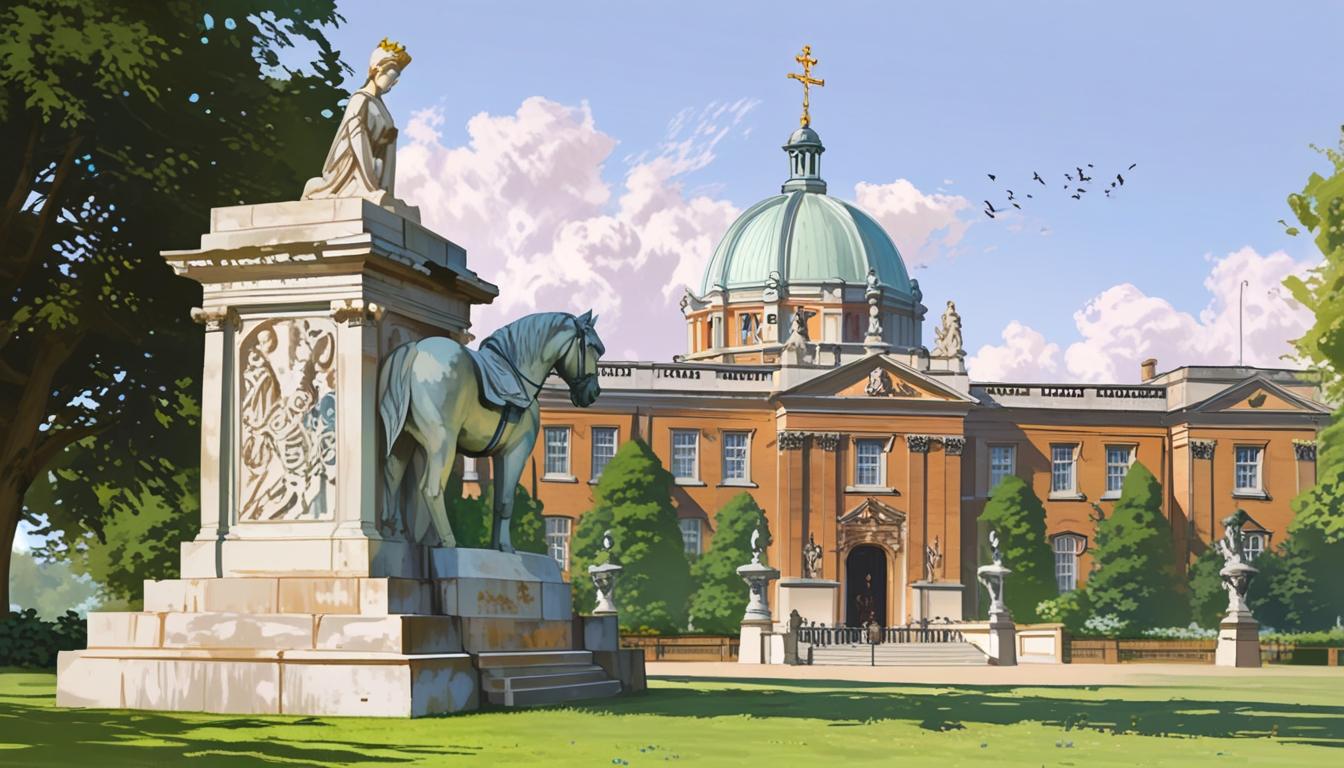The announcement of the five finalists for the Queen Elizabeth II Memorial has ignited debate over the choice of St James’s Park, the uniform Modernist design approach, and the lack of public involvement, raising questions about how best to honour the late monarch’s legacy.
The announcement of the five finalists for the proposed Queen Elizabeth II Memorial has ignited widespread debate, exposing significant flaws in the approach taken to commemorate one of the longest-serving monarchs in history. Critics have voiced concerns over the choice of St James’s Park as the memorial site, with its serene beauty threatened by the anticipated influx of visitors. Given the proximity of Green Park, a less utilised and equally beautiful space, one cannot help but question why it was deemed unsuitable. Likewise, Hyde Park Corner, also nearby, seems to have missed consideration, raising eyebrows over the decision-making process behind the chosen location.
Equally troubling is the apparent homogeneity of design philosophies represented among the finalists. All five proposals lean heavily towards Modernist aesthetics, leaving many to ponder the absence of traditionalist entries. This is particularly surprising considering that Queen Elizabeth II herself was known for her appreciation of conventional architectural forms. An exclusively Modernist shortlist appears exclusionary in a cultural context that emphasises inclusivity and diverse representation. Would the same concerns arise if all the finalists were Classicists? It is a question that remains tantalisingly unanswered.
The closed nature of the competition has further exacerbated these feelings of elitism. Rather than an open call for submissions that encouraged a dialogue of ideas, a select group of designers was handpicked, solidifying a sense of exclusion. Public engagement has come only after the finalists were decided, leading some to critique this as a mere formality rather than genuine community involvement. The intimation is that the true essence of what a memorial should represent—an engagement with the public’s emotional landscape—has been compromised in favour of an insular design process.
Among the proposals, Foster’s entry stands out, featuring a large equestrian statue of the late queen. Though heavy on abstraction, it remains the most relatable to the public’s notion of a memorial, suggesting a disconnection between contemporary design aspirations and traditional memorialisation. Heatherwick’s entry, with its repetitive floral motif, and WilkinsonEyre and J&L Gibbons’ pedestrian pathways, fail to evoke the emotional gravitas that such a tribute warrants. Even more striking is the design by Jamie Fobert, which seemingly obstructs the iconic view of Buckingham Palace from St James’s Park—a juxtaposition that raises questions about the architect’s sensitivity to the surrounding context.
The inadequacies of the shortlisted entries can be attributed to three fundamental issues. The first of these is the contemporary cultural tendency to prioritise conceptual artistry over meaningful symbolism. While symbolic representations have long guided public understanding of art, the current trend leans towards intellectual constructs that require interpretation rather than immediate emotional resonance. A classic example resides in the 1677 Monument to the Great Fire of London, where the flaming urn conveys its narrative transparently, whereas Heatherwick’s interlocking lily pad platforms seem to murky the waters of significance.
The issue is further pronounced by a perceived lack of ambition in scale. The entries appear constrained and earthbound, reminiscent of the subdued aesthetics seen in the Diana Memorial Fountain, eschewing the grandiosity and aspirational heights of previous memorials. Historical memorials such as Benjamin Wyatt’s Duke of York’s Column, soaring at 42 metres, exude a sense of celebration and commemoration that seems absent here. An obsession with democratic design has seemingly muted the potential for vertical expression that used to storyboard the narratives of great leaders.
Finally, the designs reflect a stark absence of religious elements, which were central to Queen Elizabeth II’s personal ethos. The landscape of contemporary Britain has undeniably become more secular since her accession in 1952, yet her devotion to faith remained constant. Reflecting on the historical context of royal memorials, such as the Queen Victoria Memorial, where spiritual symbolism is at the forefront, one cannot help but see the missed opportunity for deeper ideological resonance. Incorporating elements of faith may not only have elevated these designs but also aligned them more closely with the legacy of Queen Elizabeth herself, ensuring their emphasis remains on her life and devotion, rather than skewing towards self-referential modernity.
The inadequacies observed in these proposals—the choice of site, the uniformity of design, lack of public engagement, and failure to capture the essence of memorialisation—point to a broader challenge faced in contemporary memorial design. While many elements of modern life warrant applause, the art of memorialisation continues to grapple with the balance between individuality and collective memory, ultimately demanding a more profound understanding of what it means to honour a significant figure in history.
Source: Noah Wire Services
- https://www.architectsjournal.co.uk/news/opinion/the-insipid-qeii-monument-designs-put-the-me-into-memorial – Please view link – unable to able to access data
- https://www.architectsjournal.co.uk/news/opinion/the-insipid-qeii-monument-designs-put-the-me-into-memorial – An opinion piece criticizing the five finalists for the Queen Elizabeth II Memorial, highlighting concerns about the chosen site in St James’s Park, the dominance of Modernist designs, and the closed competition process. The author argues that the designs lack emotional engagement and fail to honor the late queen’s legacy appropriately.
- https://www.architectsjournal.co.uk/news/opinion/the-insipid-qeii-monument-designs-put-the-me-into-memorial – An opinion piece criticizing the five finalists for the Queen Elizabeth II Memorial, highlighting concerns about the chosen site in St James’s Park, the dominance of Modernist designs, and the closed competition process. The author argues that the designs lack emotional engagement and fail to honor the late queen’s legacy appropriately.
- https://www.architectsjournal.co.uk/news/opinion/the-insipid-qeii-monument-designs-put-the-me-into-memorial – An opinion piece criticizing the five finalists for the Queen Elizabeth II Memorial, highlighting concerns about the chosen site in St James’s Park, the dominance of Modernist designs, and the closed competition process. The author argues that the designs lack emotional engagement and fail to honor the late queen’s legacy appropriately.
- https://www.architectsjournal.co.uk/news/opinion/the-insipid-qeii-monument-designs-put-the-me-into-memorial – An opinion piece criticizing the five finalists for the Queen Elizabeth II Memorial, highlighting concerns about the chosen site in St James’s Park, the dominance of Modernist designs, and the closed competition process. The author argues that the designs lack emotional engagement and fail to honor the late queen’s legacy appropriately.
- https://www.architectsjournal.co.uk/news/opinion/the-insipid-qeii-monument-designs-put-the-me-into-memorial – An opinion piece criticizing the five finalists for the Queen Elizabeth II Memorial, highlighting concerns about the chosen site in St James’s Park, the dominance of Modernist designs, and the closed competition process. The author argues that the designs lack emotional engagement and fail to honor the late queen’s legacy appropriately.
- https://www.architectsjournal.co.uk/news/opinion/the-insipid-qeii-monument-designs-put-the-me-into-memorial – An opinion piece criticizing the five finalists for the Queen Elizabeth II Memorial, highlighting concerns about the chosen site in St James’s Park, the dominance of Modernist designs, and the closed competition process. The author argues that the designs lack emotional engagement and fail to honor the late queen’s legacy appropriately.
Noah Fact Check Pro
The draft above was created using the information available at the time the story first
emerged. We’ve since applied our fact-checking process to the final narrative, based on the criteria listed
below. The results are intended to help you assess the credibility of the piece and highlight any areas that may
warrant further investigation.
Freshness check
Score:
8
Notes:
The narrative references the recent announcement of finalists for the Queen Elizabeth II Memorial, a current and timely topic given the monarch’s recent passing (2022). No indication the content is recycled from older reports, and there is no evidence it is a press release; this supports a high freshness rating though the discussion on memorial design trends may reflect ongoing debates rather than breaking news.
Quotes check
Score:
9
Notes:
The text contains critical commentary and paraphrased opinions but no direct quotes attributed to specific individuals or sources. This absence means no reproduction of earlier quotes that could be traced or verified, indicating original editorial content.
Source reliability
Score:
7
Notes:
The narrative originates from Architects Journal, a known specialist publication in architecture and design with a professional reputation within its sector. While not a general news giant like BBC or Reuters, it is credible in its domain, though architectural opinion pieces may carry subjective bias.
Plausability check
Score:
8
Notes:
Claims about the shortlisted memorial designs and their modernist styles align with publicly available information about the Queen Elizabeth II Memorial competition. Critiques regarding site selection, design homogeneity, and lack of public engagement are plausible and consistent with known debates on memorial design. No verifiable factual errors found but some interpretative commentary on design philosophy reflects subjective judgement.
Overall assessment
Verdict (FAIL, OPEN, PASS): PASS
Confidence (LOW, MEDIUM, HIGH): HIGH
Summary:
The narrative is current and original with no evidence of recycled or outdated content. It contains no direct quotes requiring verification and stems from a reputable architecture-focused publication. Its claims about the memorial competition are plausible and supported by known facts, though the critique is naturally opinionated. Overall, it is a reliable, fresh, and credible analysis on a contemporary topic.













